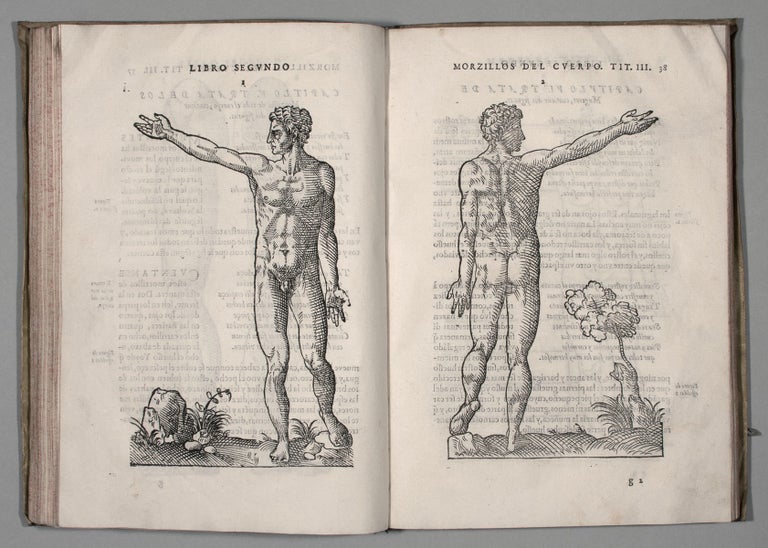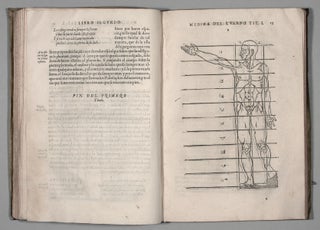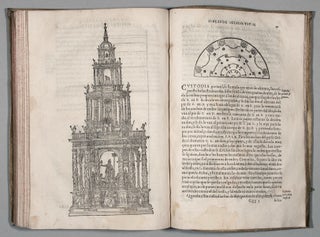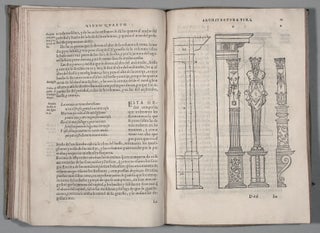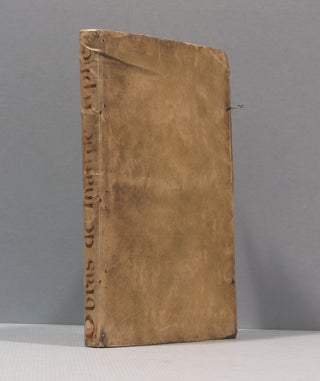De Varia Commensuracion para la Esculptura, y Architectura.
Folio [29.0 x 20.1 cm], 4 books in one volume, (6) ff., 35 ff., (1) f., 48 ff., (2) ff., (14) ff., 31 ff., with more than 300 woodcuts in the text, many of which are full page. Bound in contemporary limp vellum, manuscript title on spine, remnants of ties, red sprinkled edges. Minor soiling and edge wear to binding, front pastedown torn and unglued, book labels of the historian J. B. Bury (861-1927) and Michael Bury (on the front flyleaf) and of the 19th-century English bookseller Samuel Maynard (inside upper cover). Minor spotting and wrinkling to title, mended marginal tear to p.l. 4, the occasional contemporary annotation, minor toning to a few leaves, the occasional minor stain, small marginal burn hole at f. II.42, minor wrinkling and small marginal tear in first quire of Book II, final leaf backed and with moderate toning. Very rare, with only one recorded copy in America (Harvard), the first complete edition (see below) of the sculptor and goldsmith Juan de Arfe y Villafañe’s (1535-1600) highly influential treatise on the practice of art and architectural theory extensively illustrated with more than 300 woodcuts. This work is important for being “the first printed and illustrated treatise on artistic anatomy” (Skaarup, 254) and the second published original architectural treatise composed in Spanish, following only Diego de Sagredo’s famed Medidas del Romano (1526). Remarkably (and rather mysteriously), some two dozen of Arfe’s anatomical woodcuts in this work are derived from drawings by Leonardo da Vinci (via intermediary copies), providing a fascinating example of how Leonardo’s graphic work circulated in the wider European art world centuries before his drawings were published (Skarrup, 353-4; Röhrl, pp. 40-96, 142-45). The De Varia Commensuracion para la Esculptura, y Architectura (1585-7) – which covers in its four books geometry, human anatomy, the proportions of quadrupeds & birds, as well as classical architecture & contemporary Spanish metalwork – was the “most frequently republished” and consulted treatise on artistic practice and theory in Spain up to the turn of the 19th century (see Bonet Correa, p. 145), appearing in ten editions, the early ones being very rare. Its continuing influence has been recognized by its widespread inclusion in libraries of early Hispanic artists on both sides of the Atlantic, characterized by a “masiva presencia de Vitrubios, Vignolas, Serlios y Arfes” (Soler I Fabregat, p. 149 and passim). The painters Diego Velázquez and Alonso Cano are but a few known to have owned a copy of Arfe (Fajardo, 88-90). “The success of the Varia in Spain and in Latin America was extraordinary, being a compendium in a single volume of distinct fields of artistic and scientific knowledge, the borders of which were not at the time established with the same categorical precision as they are today” (Bonet Correa, 157). Books Two and Four are the two most historically influential parts of the Varia. Book Two, on human anatomy, is divided into four subchapters on proportion, osteology, myology and foreshortening of the human figure. Arfe claims here a number of influences, including Dürer’s treatise on proportion (1528) and Juan Valverde de Amusco’s interpretations of Vesalius’ Fabrica, but he also mentions the artists Pollaiuolo, Baccio Bandinelli, Raphael, Donatello, Mantegna, Michelangelo and the Spaniards Pedro Berruguete and Gaspar Bezerra (ff. 1v-2v). Arfe comes to the practice of artistic anatomy having spent time as a student training in the dissection theater under the direction of the famed physician Cosme de Medina (d. 1591) at the University of Salamanca (f. 25v), leading scholars to remark that “Nowhere in an Iberian context was the close, even dependent, relationship between anatomists and artists more evident than in Juan de Arfe y Villafañe’s Varia … the Libro segundo is a rare and unique source produced by an anatomically trained artist of the late Spanish Renaissance” (Skaarup, 246). According to Choulant, the Varia “should… be considered the earliest of the numerous works which dealt with anatomy for graphic and plastic artists…” (Choulant, p. 32). Book Three of the Varia, on the proportions of animals, draws heavily from Conrad Gessner’s four-volume Historiae Animalium (1551-8) and includes, along with depictions of more common birds and quadrupeds, the images of an elephant, camels, ostrich, and Dürer’s famed rhinoceros. Arfe’s horse recalls the equestrian statues of the Italian Renaissance and serves as a reminder that establishing the precise proportions of the horse was also a preoccupation of such artists as Leonardo (in the Codex Huygens) and Sebald Beham (Proporcion der Ross, 1528). In Book 4, Arfe writes of the Roman ruins in Spain, the architecture of Bramante, Baldassare Peruzzi, and Alberti, as well as modern Spanish architects and those goldsmiths whose work (on liturgical vessels) can be characterized as ‘micro-architecture,’ beginning with the metalwork of his grandfather. Arfe illustrates the classical Orders based on Serlio, adding a sixth ‘Attic’ order, and treats various aspects of architectural ornament. At the time of its publication, the Varia was only the second original architectural treatise composed in Spanish – following Diego de Sagredo’s famed Medidas del Romano (1526) and derivative works of translation such as Villalpando’s Tercero y Quarto libro de Serlio (1552), Zamorano’s Diez Libros de Architectura of Alberti (1582), Miguel de Urrea’s Vitruvio (1582) (Fajardo, 130; Bonet Correa, 158). “Arfe’s treatise, with its more timeless character, transcended its own era” (Bonet Correa, 158). Although the Medidas del Romano of Diego Sagredo appeared in three Spanish editions and further French and Portuguese translations, its emphasis on the ‘Plateresque’ style of architecture contributed to the waning of its popularity during the 17th century, even as the popularity of Arfe’s treatise increased. Arfe extends Book 4 with a highly original discussion of metalwork, in which he aligns his own specialty with the more theoretically sophisticated field of pure architecture. His woodcuts of liturgical items (monstrance, chalice, aquamanile, crosier, crosses, candelabra, censer, etc.) are given a rigorous proportional treatment, with more sophisticated ‘micro-architecture’ custodias being shown in plan as well as in elevation, in the manner of full-scale buildings. Some of these illustrations depict surviving works by Arfe, while others are taken to be designs for lost or still unidentified pieces. It should be noted that while Arfe – despite the popularity of his treatise – perhaps was unable in his time to elevate his craft as a theoretically complex art alongside painting, sculpture and architecture, in recent times, art-historical research has vindicated his contention that metalwork of the highest quality should be prized not only for its pure material value and symbolic-liturgical importance, but also for its participation in the wider debates about the nature of representation, the supremacy of panting vs. sculpture vs. architecture, etc. Books One, Two and Four of the Varia are dated 1585 on their colophons, while Book 3 is dated 1587. The first two books are occasionally found bound without Books 3 and 4, and it is surmised that the final two books appeared in 1587 (in spite of the 1585 date on Book 4), after an interruption in printing caused by a fire or a controversy about privileges, at which point the complete work was bound together as seen in the present copy (Fajardo, 72-2; Bonet Correa, 159). Juan de Arfe was the third in a line of renowned metalworkers originally hailing from Germany – following his grandfather, Enrique, and father, Antonio – and is known to have been active in Valladolid, Sevilla, and Madrid. His custodias (monstrances) at the Cathedral of Sevilla and Avila remain celebrated works of Renaissance goldsmithing in the classical mode, showing the influence of Donatello and Bramante, among others. “Arfe’s last sculptural works of life-size human figures, such as the exquisite tomb monument for the Archbishop of Seville, Don Cristóbal de Rojas, reveal his development as a leading naturalist of the late Spanish Renaissance” (Skaarup, 253; see principally Sanz, and Fajardo for Arfe’s artistic activity). In addition to the Varia, Arfe published Quilatador de plata, oro y piedras (1572) and Descripción de la traça y ornato de la custodia de plata de la Sancta Yglesia de Sevilla (1587), both short tracts on metalwork. The present copy, intriguingly, carries the apparent signature of Arphe himself on the bottom margin of the title page. This exact signature is also present in the same location in copies now at the Biblioteca Nacional de España and the Biblioteca de Castilla y Léon (effaced), a detail which might shed further light on the early publication history of the Varia.
Sold

